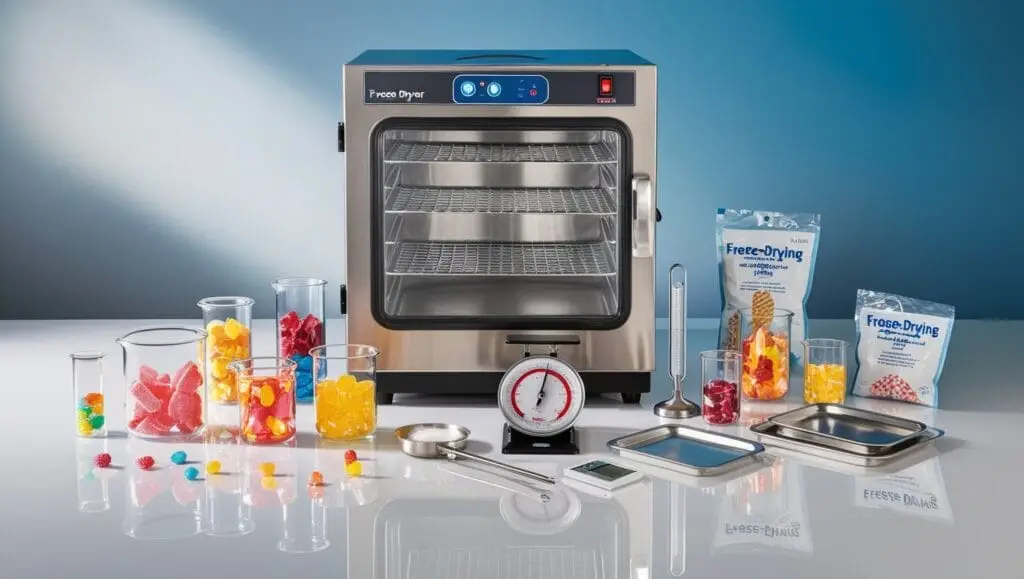Intro
Have you ever wondered how to freeze dry candy at home? If you love experimenting in the kitchen and enjoy unique textures in your treats, freeze-drying could be the perfect hobby for you. Freeze-drying candy not only preserves its flavor but also gives it a delightful crunch that enhances its appeal. In this blog post, we’ll delve into everything you need to know about freeze drying candy, from the basics to some creative uses for your newly preserved sweets.

What Is Freeze Drying and How Does It Work?
Freeze drying, or lyophilization, is a dehydration process that effectively removes moisture from perishable materials. The technique involves three main stages: freezing, primary drying (sublimation), and secondary drying (desorption). Initially, the candy is frozen solid, locking in its structure and flavor. Next, the surrounding pressure is reduced, and heat is applied to allow the frozen water within the candy to sublimate, meaning it transitions directly from a solid state to a vapor without passing through a liquid phase. This is known as primary drying. Finally, secondary drying removes any remaining moisture molecules, ensuring the candy is completely dry.
This process is particularly beneficial for preserving the taste, texture, and nutritional value of the candy. Unlike traditional drying methods that can alter the candy’s consistency and flavor, freeze drying maintains its original qualities. The result is a lightweight, porous product that retains the candy’s natural sweetness and crunchiness. The absence of moisture also means that freeze-dried candy is less prone to microbial growth, extending its shelf life significantly.
The science behind freeze drying may sound complex, but the basic principle is simple: remove water without altering the essential properties of the candy. By doing so, you create a product that not only tastes delicious but also has a unique, airy texture. Freeze-dried candy doesn’t require rehydration and can be enjoyed in its dry form, making it an excellent snack for various occasions. The method’s ability to preserve the integrity of the candy makes it a popular choice among food preservation enthusiasts.
Benefits of Freeze-Drying Candy
Freeze-drying candy offers numerous advantages, enhancing both its preservation and sensory qualities. One of the most significant benefits is the extended shelf life. Without the need for preservatives, freeze-dried candy can remain fresh for months or even years when stored correctly. This makes it an excellent choice for long-term storage or emergency food supplies.
The flavor of freeze-dried candy becomes more concentrated, providing an intensified taste experience that can make your favorite sweets even more enjoyable. The unique texture that results from freeze-drying is another key benefit. The candy turns airy and crunchy, offering a delightful variation from its original form. This transformation can make familiar candies feel novel and exciting.
Moreover, freeze-dried candy is exceptionally lightweight, making it easy to store and transport. This characteristic is particularly beneficial for those who need portable snacks, such as hikers, campers, or travelers. The absence of moisture means the candy is less prone to microbial growth, adding to its safety and longevity.
In addition to these practical benefits, freeze-dried candy can serve as a versatile ingredient in various culinary applications. Its unique texture and intensified flavor make it an excellent topping for desserts like ice cream, yogurt, and baked goods. It can also be crushed and used as a flavorful coating for cake pops or truffles, adding both taste and visual appeal.
Overall, the benefits of freeze-drying candy extend beyond mere preservation, offering a range of enhancements that can elevate your snacking and culinary experiences.
Equipment Needed for Freeze Drying Candy

To get started with freeze-drying candy at home, you’ll need some specific equipment. The centerpiece of your setup is a freeze dryer, a machine designed to remove moisture from food through a process involving freezing and vacuum pressure. While freeze dryers can be a significant investment, they are essential for achieving the best results and come in various sizes to fit your needs.
In addition to the freeze dryer, you’ll also need airtight storage containers or vacuum-seal bags to store your freeze-dried candy. This will help maintain the candy’s crisp texture and prolonged shelf life by protecting it from moisture.
It’s also a good idea to have a pair of gloves on hand for handling the freeze -dried candy. The candy can be quite delicate, and the gloves will help prevent it from crumbling or breaking apart.
Other useful tools include a sharp knife or scissors for cutting larger candies into smaller, more manageable pieces. This ensures even freeze-drying and optimal texture. Trays that fit inside your freeze dryer are typically provided with the machine, but having extras can be useful if you’re freeze-drying large batches.
For those who like to keep things organized, consider labeling supplies. Labels can help you identify different types of candy, especially if you’re experimenting with multiple varieties at once.
Lastly, a vacuum sealer is another valuable tool for preserving the quality of your freeze-dried candy. While not strictly necessary, a vacuum sealer can significantly extend the shelf life of your treats by removing any residual air from storage bags.
With the right equipment, you’ll be well on your way to creating delicious, long-lasting freeze-dried candy at home.
Step-by-Step Guide to Freeze Drying Candy
1. Choose Your Candy: Opt for gummies, marshmallows, taffy, or other candies you’re curious about.
2. Prepare the Candy: Slice larger candies into smaller, uniform pieces. This helps ensure they freeze-dry evenly.
3. Arrange on Trays: Lay out the candy in a single layer on the trays that come with your freeze dryer. Avoid overlapping to ensure proper drying.
4. Load the Freeze Dryer: Insert the trays into the freeze dryer. Follow the machine’s specific settings for candy to achieve the best results.
5. Start the Process: Activate the freeze dryer. The cycle can take anywhere from 20 to 40 hours depending on your machine and the type of candy.
6. Monitor Progress: Once the cycle is complete, break a piece to check if it’s fully dry. If any moisture remains, extend the cycle for a few more hours.
7. Store Properly: Transfer the completely freeze-dried candy to airtight containers or vacuum-sealed bags to maintain its crisp texture and long shelf life.
Tips and Tricks for Successful Freeze Drying
To ensure your freeze-drying endeavors are successful, consider the following tips and tricks:
Pre-freezing your candy in a regular freezer before transferring it to the freeze dryer can accelerate the process. This initial step helps lock in the candy’s structure and flavor, making the overall drying more efficient.
Experiment with your freeze dryer settings to find the optimal conditions for different types of candy. Each variety may require specific adjustments in temperature and time to achieve the best results. Don’t be afraid to tweak the settings and take notes on what works best.
Avoid overloading the trays in your freeze dryer. Overcrowding can lead to uneven drying and compromise the texture and quality of your candy. Spread the candy pieces out in a single layer, ensuring they don’t overlap.
Consider the size of the candy pieces. Cutting larger candies into smaller, uniform chunks can promote even drying and enhance the final texture. Smaller pieces will dry more quickly and thoroughly than larger ones.
Invest in high-quality airtight containers or vacuum-seal bags for storing your freeze-dried candy. Proper storage is crucial for maintaining the candy’s crisp texture and preventing it from absorbing moisture from the air.
Keep track of your batches with labels. If you’re working with multiple types of candy, labeling can help you easily identify each variety and keep your experiments organized.
Check for dryness periodically during the cycle. If the candy still feels slightly moist, don’t hesitate to extend the drying time. Ensuring complete dryness is key to achieving the desired texture and shelf life.
By following these tips and tricks, you’ll enhance the efficiency and outcome of your freeze-drying process, allowing you to enjoy perfectly preserved candy every time.
Creative Uses for Freeze-Dried Candy

Freeze-dried candy can add a unique twist to various dishes and treats. Its airy texture and intensified flavor make it an excellent topping for ice cream, yogurt, or even pancakes. Crush it into fine pieces to create a colorful and crunchy sprinkle that enhances the visual and taste appeal of your desserts.
In baking, freeze-dried candy can be incorporated into cookie dough, brownie batter, or cake mixes for added texture and flavor. It holds up well during baking, retaining its crunchiness and providing delightful bursts of sweetness.
You can also use freeze-dried candy in savory dishes. Incorporate it into salad dressings or sprinkle it over roasted vegetables for a surprising hint of sweetness and crunch. It pairs particularly well with nuts and cheeses, making it a versatile addition to charcuterie boards.
For those who enjoy beverages, freeze-dried candy can be used as an inventive garnish for cocktails and mocktails. Rim your glass with crushed candy for an extra layer of flavor or drop whole pieces into drinks for a fun, dissolving treat.
Trail mix gets a gourmet upgrade with the addition of freeze-dried candy, blending seamlessly with nuts, seeds, and dried fruits for a balanced and energizing snack. Its light weight also makes it perfect for hiking and travel. The creative possibilities are endless, making freeze-dried candy a versatile ingredient in both sweet and savory culinary creations.

